![The Fundamental Theorem of Calculus says that the integral over line segment [a,b] depends only on the values of the antiderivative at the endpoints of [a,b]. A graph in quadrant 1 of a generic function f(x). It is an increasing concave up function for the first quarter, an increasing concave down function for the second quarter, a decreasing concave down function for the third quarter, and an increasing concave down function for the last quarter. In the second quarter, a point a is marked on the x axis, and in the third quarter, a point b is marked on the x axis. The area under the curve and between a and b is shaded. This area is labeled the integral from a to b of f(x) dx.](../resources/CNX_Calc_Figure_16_04_001.jpg)
In this section, we examine Green’s theorem, which is an extension of the Fundamental Theorem of Calculus to two dimensions. Green’s theorem has two forms: a circulation form and a flux form, both of which require region D in the double integral to be simply connected. However, we will extend Green’s theorem to regions that are not simply connected.
Put simply, Green’s theorem relates a line integral around a simply closed plane curve C and a double integral over the region enclosed by C. The theorem is useful because it allows us to translate difficult line integrals into more simple double integrals, or difficult double integrals into more simple line integrals.
Recall that the Fundamental Theorem of Calculus says that
As a geometric statement, this equation says that the integral over the region below the graph of
and above the line segment
depends only on the value of F at the endpoints a and b of that segment. Since the numbers a and b are the boundary of the line segment
the theorem says we can calculate integral
based on information about the boundary of line segment
([link]). The same idea is true of the Fundamental Theorem for Line Integrals:
When we have a potential function (an “antiderivative”), we can calculate the line integral based solely on information about the boundary of curve C.
![The Fundamental Theorem of Calculus says that the integral over line segment [a,b] depends only on the values of the antiderivative at the endpoints of [a,b]. A graph in quadrant 1 of a generic function f(x). It is an increasing concave up function for the first quarter, an increasing concave down function for the second quarter, a decreasing concave down function for the third quarter, and an increasing concave down function for the last quarter. In the second quarter, a point a is marked on the x axis, and in the third quarter, a point b is marked on the x axis. The area under the curve and between a and b is shaded. This area is labeled the integral from a to b of f(x) dx.](../resources/CNX_Calc_Figure_16_04_001.jpg)
Green’s theorem takes this idea and extends it to calculating double integrals. Green’s theorem says that we can calculate a double integral over region D based solely on information about the boundary of D. Green’s theorem also says we can calculate a line integral over a simple closed curve C based solely on information about the region that C encloses. In particular, Green’s theorem connects a double integral over region D to a line integral around the boundary of D.
The first form of Green’s theorem that we examine is the circulation form. This form of the theorem relates the vector line integral over a simple, closed plane curve C to a double integral over the region enclosed by C. Therefore, the circulation of a vector field along a simple closed curve can be transformed into a double integral and vice versa.
Let D be an open, simply connected region with a boundary curve C that is a piecewise smooth, simple closed curve oriented counterclockwise ([link]). Let
be a vector field with component functions that have continuous partial derivatives on D. Then,
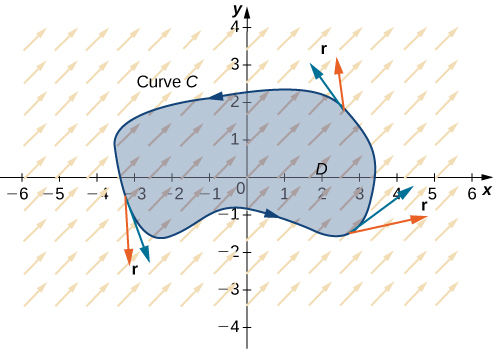
Notice that Green’s theorem can be used only for a two-dimensional vector field F. If F is a three-dimensional field, then Green’s theorem does not apply. Since
this version of Green’s theorem is sometimes referred to as the tangential form of Green’s theorem.
The proof of Green’s theorem is rather technical, and beyond the scope of this text. Here we examine a proof of the theorem in the special case that D is a rectangle. For now, notice that we can quickly confirm that the theorem is true for the special case in which
is conservative. In this case,
because the circulation is zero in conservative vector fields. By [link], F satisfies the cross-partial condition, so
Therefore,
which confirms Green’s theorem in the case of conservative vector fields.
Let’s now prove that the circulation form of Green’s theorem is true when the region D is a rectangle. Let D be the rectangle
oriented counterclockwise. Then, the boundary C of D consists of four piecewise smooth pieces
and
([link]). We parameterize each side of D as follows:
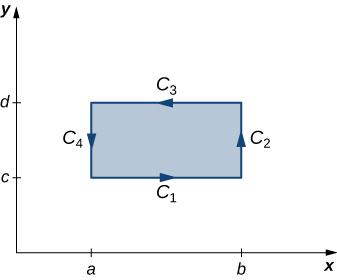
Then,
By the Fundamental Theorem of Calculus,
Therefore,
But,
Therefore,
and we have proved Green’s theorem in the case of a rectangle.
To prove Green’s theorem over a general region D, we can decompose D into many tiny rectangles and use the proof that the theorem works over rectangles. The details are technical, however, and beyond the scope of this text.
□
Calculate the line integral
where C is a rectangle with vertices
and
oriented counterclockwise.
Let
Then,
and
Therefore,
Let D be the rectangular region enclosed by C ([link]). By Green’s theorem,
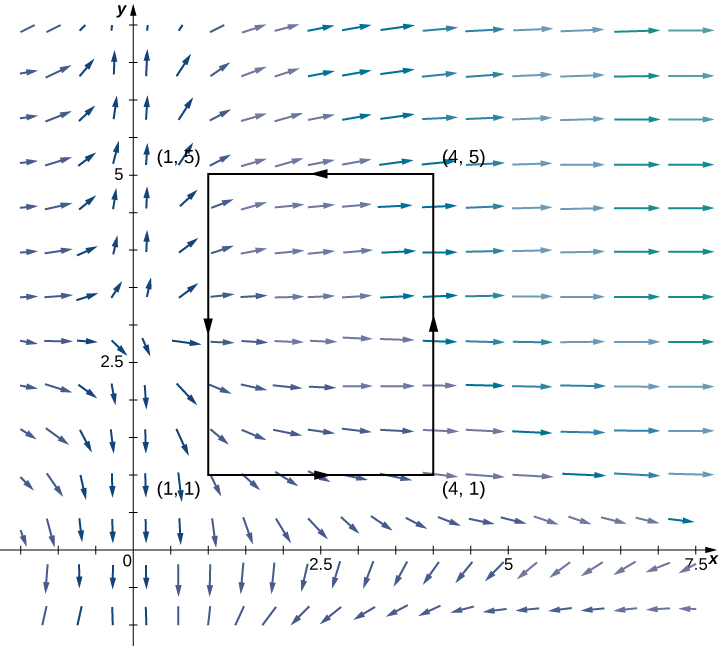
If we were to evaluate this line integral without using Green’s theorem, we would need to parameterize each side of the rectangle, break the line integral into four separate line integrals, and use the methods from Line Integrals to evaluate each integral. Furthermore, since the vector field here is not conservative, we cannot apply the Fundamental Theorem for Line Integrals. Green’s theorem makes the calculation much simpler.
Calculate the work done on a particle by force field
as the particle traverses circle
exactly once in the counterclockwise direction, starting and ending at point
Use Green’s theorem to calculate line integral
where C is a right triangle with vertices
and
oriented counterclockwise.
Transform the line integral into a double integral.
In the preceding two examples, the double integral in Green’s theorem was easier to calculate than the line integral, so we used the theorem to calculate the line integral. In the next example, the double integral is more difficult to calculate than the line integral, so we use Green’s theorem to translate a double integral into a line integral.
Let C denote the ellipse and let D be the region enclosed by C. Recall that ellipse C can be parameterized by
Calculating the area of D is equivalent to computing double integral
To calculate this integral without Green’s theorem, we would need to divide D into two regions: the region above the x-axis and the region below. The area of the ellipse is
These two integrals are not straightforward to calculate (although when we know the value of the first integral, we know the value of the second by symmetry). Instead of trying to calculate them, we use Green’s theorem to transform
into a line integral around the boundary C.
Consider vector field
Then,
and
and therefore
Notice that F was chosen to have the property that
Since this is the case, Green’s theorem transforms the line integral of F over C into the double integral of 1 over D.
By Green’s theorem,
Therefore, the area of the ellipse is
In [link], we used vector field
to find the area of any ellipse. The logic of the previous example can be extended to derive a formula for the area of any region D. Let D be any region with a boundary that is a simple closed curve C oriented counterclockwise. If
then
Therefore, by the same logic as in [link],
It’s worth noting that if
is any vector field with
then the logic of the previous paragraph works. So. [link] is not the only equation that uses a vector field’s mixed partials to get the area of a region.
The circulation form of Green’s theorem relates a double integral over region D to line integral
where C is the boundary of D. The flux form of Green’s theorem relates a double integral over region D to the flux across boundary C. The flux of a fluid across a curve can be difficult to calculate using the flux line integral. This form of Green’s theorem allows us to translate a difficult flux integral into a double integral that is often easier to calculate.
Let D be an open, simply connected region with a boundary curve C that is a piecewise smooth, simple closed curve that is oriented counterclockwise ([link]). Let
be a vector field with component functions that have continuous partial derivatives on an open region containing D. Then,
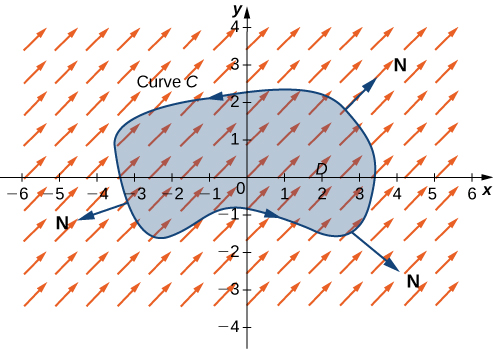
Because this form of Green’s theorem contains unit normal vector N, it is sometimes referred to as the normal form of Green’s theorem.
Recall that
Let
and
By the circulation form of Green’s theorem,
□
Let C be a circle of radius r centered at the origin ([link]) and let
Calculate the flux across C.
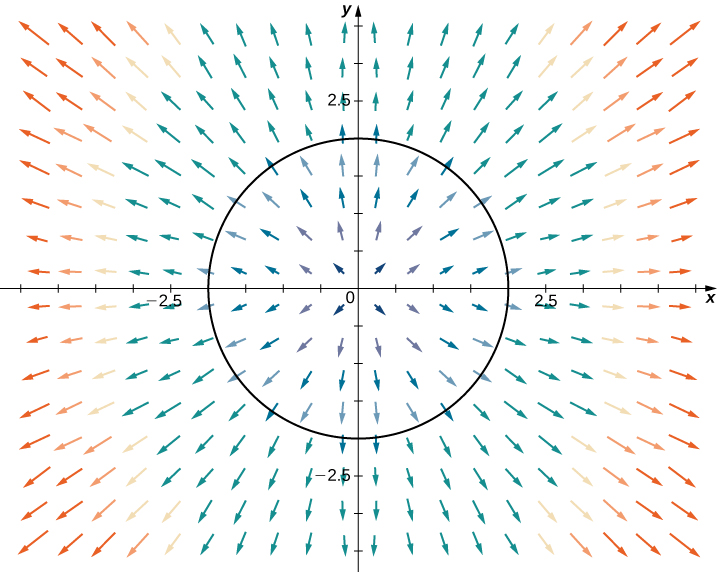
Let D be the disk enclosed by C. The flux across C is
We could evaluate this integral using tools we have learned, but Green’s theorem makes the calculation much more simple. Let
and
so that
Note that
and therefore
By Green’s theorem,
Since
is the area of the circle,
Therefore, the flux across C is
Let S be the triangle with vertices
and
oriented clockwise ([link]). Calculate the flux of
across S.
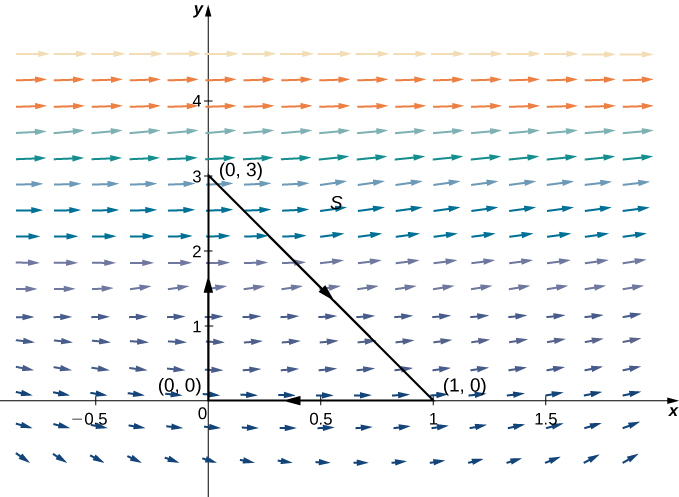
To calculate the flux without Green’s theorem, we would need to break the flux integral into three line integrals, one integral for each side of the triangle. Using Green’s theorem to translate the flux line integral into a single double integral is much more simple.
Let D be the region enclosed by S. Note that
and
therefore,
Green’s theorem applies only to simple closed curves oriented counterclockwise, but we can still apply the theorem because
and
is oriented counterclockwise. By Green’s theorem, the flux is
Notice that the top edge of the triangle is the line
Therefore, in the iterated double integral, the y-values run from
to
and we have
Calculate the flux of
across a unit circle oriented counterclockwise.
Apply Green’s theorem and use polar coordinates.
Water flows from a spring located at the origin. The velocity of the water is modeled by vector field
m/sec. Find the amount of water per second that flows across the rectangle with vertices
oriented counterclockwise ([link]).
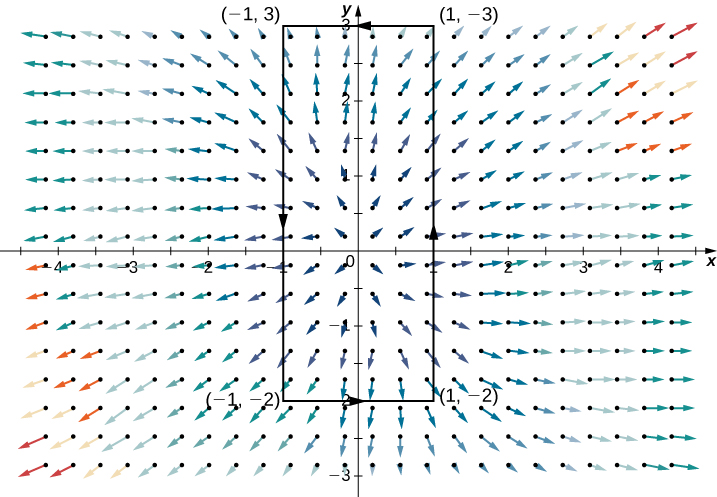
Let C represent the given rectangle and let D be the rectangular region enclosed by C. To find the amount of water flowing across C, we calculate flux
Let
and
so that
Then,
and
By Green’s theorem,
Therefore, the water flux is 80 m2/sec.
Recall that if vector field F is conservative, then F does no work around closed curves—that is, the circulation of F around a closed curve is zero. In fact, if the domain of F is simply connected, then F is conservative if and only if the circulation of F around any closed curve is zero. If we replace “circulation of F” with “flux of F,” then we get a definition of a source-free vector field. The following statements are all equivalent ways of defining a source-free field
on a simply connected domain (note the similarities with properties of conservative vector fields):
across any closed curve C is zero.
and
are curves in the domain of F with the same starting points and endpoints, then
In other words, flux is independent of path.
for F. A stream function for
is a function g such that
and
Geometrically,
is tangential to the level curve of g at
Since the gradient of g is perpendicular to the level curve of g at
stream function g has the property
for any point
in the domain of g. (Stream functions play the same role for source-free fields that potential functions play for conservative fields.)
Verify that rotation vector field
is source free, and find a stream function for F.
Note that the domain of F is all of
which is simply connected. Therefore, to show that F is source free, we can show any of items 1 through 4 from the previous list to be true. In this example, we show that item 4 is true. Let
and
Then
and therefore
Thus, F is source free.
To find a stream function for F, proceed in the same manner as finding a potential function for a conservative field. Let g be a stream function for F. Then
which implies that
Since
we have
Therefore,
Letting
gives stream function
To confirm that g is a stream function for F, note that
and
Notice that source-free rotation vector field
is perpendicular to conservative radial vector field
([link]).
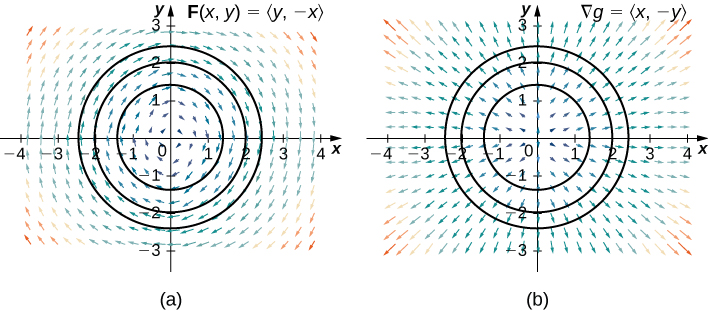
Find a stream function for vector field
Follow the outline provided in the previous example.
Vector fields that are both conservative and source free are important vector fields. One important feature of conservative and source-free vector fields on a simply connected domain is that any potential function
of such a field satisfies Laplace’s equation
Laplace’s equation is foundational in the field of partial differential equations because it models such phenomena as gravitational and magnetic potentials in space, and the velocity potential of an ideal fluid. A function that satisfies Laplace’s equation is called a harmonic function. Therefore any potential function of a conservative and source-free vector field is harmonic.
To see that any potential function of a conservative and source-free vector field on a simply connected domain is harmonic, let
be such a potential function of vector field
Then,
and
because
Therefore,
and
Since F is source free,
and we have that
is harmonic.
For vector field
verify that the field is both conservative and source free, find a potential function for F, and verify that the potential function is harmonic.
Let
and
Notice that the domain of F is all of two-space, which is simply connected. Therefore, we can check the cross-partials of F to determine whether F is conservative. Note that
so F is conservative. Since
and
and the field is source free.
To find a potential function for F, let
be a potential function. Then,
so
Integrating this equation with respect to x gives
Since
differentiating
with respect to y gives
Therefore, we can take
and
is a potential function for
To verify that
is a harmonic function, note that
and
Therefore,
and
satisfies Laplace’s equation.
Is the function
harmonic?
No
Determine whether the function satisfies Laplace’s equation.
Green’s theorem, as stated, applies only to regions that are simply connected—that is, Green’s theorem as stated so far cannot handle regions with holes. Here, we extend Green’s theorem so that it does work on regions with finitely many holes ([link]).
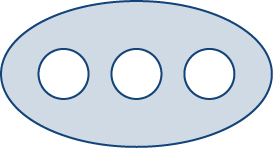
Before discussing extensions of Green’s theorem, we need to go over some terminology regarding the boundary of a region. Let D be a region and let C be a component of the boundary of D. We say that C is positively oriented if, as we walk along C in the direction of orientation, region D is always on our left. Therefore, the counterclockwise orientation of the boundary of a disk is a positive orientation, for example. Curve C is negatively oriented if, as we walk along C in the direction of orientation, region D is always on our right. The clockwise orientation of the boundary of a disk is a negative orientation, for example.
Let D be a region with finitely many holes (so that D has finitely many boundary curves), and denote the boundary of D by
([link]). To extend Green’s theorem so it can handle D, we divide region D into two regions,
and
(with respective boundaries
and
in such a way that
and neither
nor
has any holes ([link]).
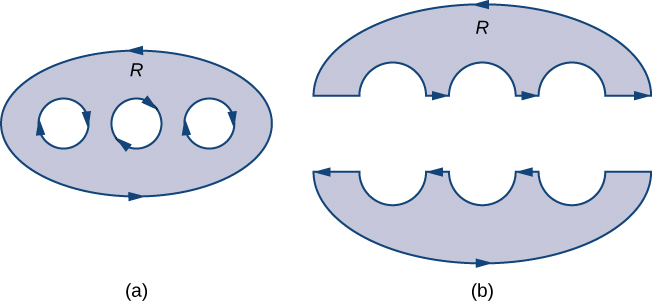
Assume the boundary of D is oriented as in the figure, with the inner holes given a negative orientation and the outer boundary given a positive orientation. The boundary of each simply connected region
and
is positively oriented. If F is a vector field defined on D, then Green’s theorem says that
Therefore, Green’s theorem still works on a region with holes.
To see how this works in practice, consider annulus D in [link] and suppose that
is a vector field defined on this annulus. Region D has a hole, so it is not simply connected. Orient the outer circle of the annulus counterclockwise and the inner circle clockwise ([link]) so that, when we divide the region into
and
we are able to keep the region on our left as we walk along a path that traverses the boundary. Let
be the upper half of the annulus and
be the lower half. Neither of these regions has holes, so we have divided D into two simply connected regions.
We label each piece of these new boundaries as
for some i, as in [link]. If we begin at P and travel along the oriented boundary, the first segment is
then
and
Now we have traversed
and returned to P. Next, we start at P again and traverse
Since the first piece of the boundary is the same as
in
but oriented in the opposite direction, the first piece of
is
Next, we have
then
and finally
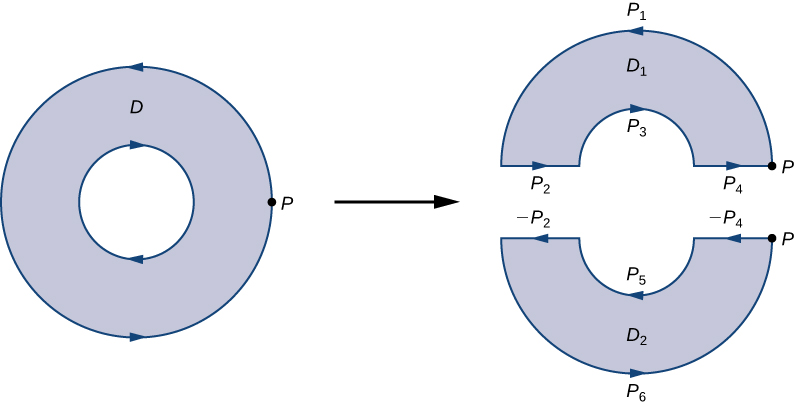
[link] shows a path that traverses the boundary of D. Notice that this path traverses the boundary of region
returns to the starting point, and then traverses the boundary of region
Furthermore, as we walk along the path, the region is always on our left. Notice that this traversal of the
paths covers the entire boundary of region D. If we had only traversed one portion of the boundary of D, then we cannot apply Green’s theorem to D.
The boundary of the upper half of the annulus, therefore, is
and the boundary of the lower half of the annulus is
Then, Green’s theorem implies
Therefore, we arrive at the equation found in Green’s theorem—namely,
The same logic implies that the flux form of Green’s theorem can also be extended to a region with finitely many holes:
Calculate integral
where D is the annulus given by the polar inequalities
Although D is not simply connected, we can use the extended form of Green’s theorem to calculate the integral. Since the integration occurs over an annulus, we convert to polar coordinates:
Let
and let C be any simple closed curve in a plane oriented counterclockwise. What are the possible values of
We use the extended form of Green’s theorem to show that
is either 0 or
—that is, no matter how crazy curve C is, the line integral of F along C can have only one of two possible values. We consider two cases: the case when C encompasses the origin and the case when C does not encompass the origin.
In this case, the region enclosed by C is simply connected because the only hole in the domain of F is at the origin. We showed in our discussion of cross-partials that F satisfies the cross-partial condition. If we restrict the domain of F just to C and the region it encloses, then F with this restricted domain is now defined on a simply connected domain. Since F satisfies the cross-partial property on its restricted domain, the field F is conservative on this simply connected region and hence the circulation
is zero.
In this case, the region enclosed by C is not simply connected because this region contains a hole at the origin. Let
be a circle of radius a centered at the origin so that
is entirely inside the region enclosed by C ([link]). Give
a clockwise orientation.
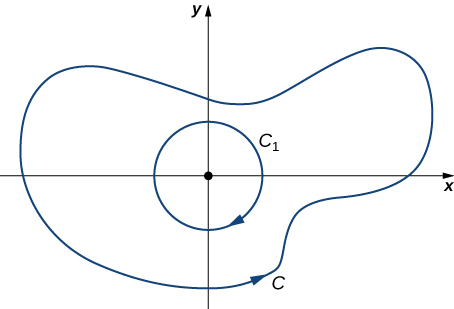
Let D be the region between
and C, and C is orientated counterclockwise. By the extended version of Green’s theorem,
and therefore
Since
is a specific curve, we can evaluate
Let
be a parameterization of
Then,
Therefore,
Calculate integral
where D is the annulus given by the polar inequalities
and
Use the extended version of Green’s theorem.

Imagine you are a doctor who has just received a magnetic resonance image of your patient’s brain. The brain has a tumor ([link]). How large is the tumor? To be precise, what is the area of the red region? The red cross-section of the tumor has an irregular shape, and therefore it is unlikely that you would be able to find a set of equations or inequalities for the region and then be able to calculate its area by conventional means. You could approximate the area by chopping the region into tiny squares (a Riemann sum approach), but this method always gives an answer with some error.
Instead of trying to measure the area of the region directly, we can use a device called a rolling planimeter to calculate the area of the region exactly, simply by measuring its boundary. In this project you investigate how a planimeter works, and you use Green’s theorem to show the device calculates area correctly.
A rolling planimeter is a device that measures the area of a planar region by tracing out the boundary of that region ([link]). To measure the area of a region, we simply run the tracer of the planimeter around the boundary of the region. The planimeter measures the number of turns through which the wheel rotates as we trace the boundary; the area of the shape is proportional to this number of wheel turns. We can derive the precise proportionality equation using Green’s theorem. As the tracer moves around the boundary of the region, the tracer arm rotates and the roller moves back and forth (but does not rotate).

Let C denote the boundary of region D, the area to be calculated. As the tracer traverses curve C, assume the roller moves along the y-axis (since the roller does not rotate, one can assume it moves along a straight line). Use the coordinates
to represent points on boundary C, and coordinates
to represent the position of the pivot. As the planimeter traces C, the pivot moves along the y-axis while the tracer arm rotates on the pivot.
Watch a short animation of a planimeter in action.
Begin the analysis by considering the motion of the tracer as it moves from point
counterclockwise to point
that is close to
([link]). The pivot also moves, from point
to nearby point
How much does the wheel turn as a result of this motion? To answer this question, break the motion into two parts. First, roll the pivot along the y-axis from
to
without rotating the tracer arm. The tracer arm then ends up at point
while maintaining a constant angle
with the x-axis. Second, rotate the tracer arm by an angle
without moving the roller. Now the tracer is at point
Let
be the distance from the pivot to the wheel and let L be the distance from the pivot to the tracer (the length of the tracer arm).
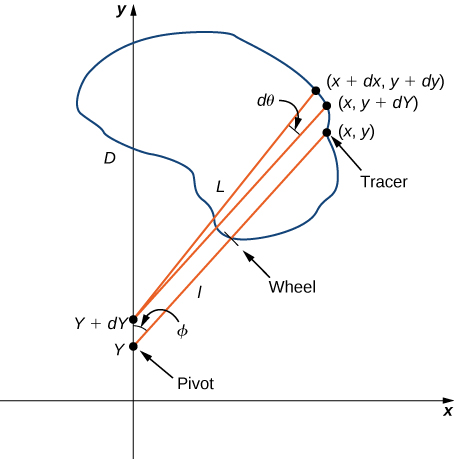
Total wheel roll
Now that you have an equation for the total rolling distance of the wheel, connect this equation to Green’s theorem to calculate area D enclosed by C.
and use this inequality to show there is a unique value of Y for each point
Total wheel roll
It took a bit of work, but this equation says that the variable of integration Y in step 3 can be replaced with y.
The logic is similar to the logic used to show that the area of
You now know how a planimeter works and you have used Green’s theorem to justify that it works. To calculate the area of a planar region D, use a planimeter to trace the boundary of the region. The area of the region is the length of the tracer arm multiplied by the distance the wheel rolled.
In the flux form, the integrand is
where C is the boundary of D
where C is the boundary of D
For the following exercises, evaluate the line integrals by applying Green’s theorem.
where C is the path from (0, 0) to (1, 1) along the graph of
and from (1, 1) to (0, 0) along the graph of
oriented in the counterclockwise direction
where C is the boundary of the region lying between the graphs of
and
oriented in the counterclockwise direction
where C is defined by
oriented in the counterclockwise direction
where C is the boundary of the region lying between the graphs of
and
oriented in the counterclockwise direction
where C is the boundary of the region lying between the graphs of
and
oriented in the counterclockwise direction
where C consists of line segment C1 from
to (1, 0), followed by the semicircular arc C2 from (1, 0) back to (1, 0)
For the following exercises, use Green’s theorem.
Let C be the curve consisting of line segments from (0, 0) to (1, 1) to (0, 1) and back to (0, 0). Find the value of
Evaluate line integral
where C is the boundary of the region between circles
and
and is a positively oriented curve.
Find the counterclockwise circulation of field
around and over the boundary of the region enclosed by curves
and
in the first quadrant and oriented in the counterclockwise direction.
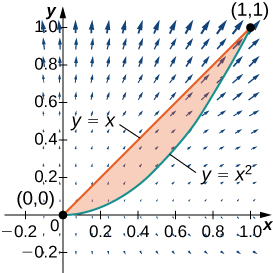
Evaluate
where C is the positively oriented circle of radius 2 centered at the origin.
Evaluate
where C includes the two circles of radius 2 and radius 1 centered at the origin, both with positive orientation.
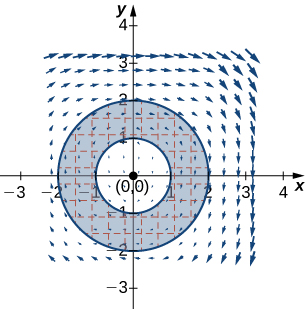
Calculate
where C is a circle of radius 2 centered at the origin and oriented in the counterclockwise direction.
Calculate integral
along triangle C with vertices (0, 0), (1, 0) and (1, 1), oriented counterclockwise, using Green’s theorem.
Evaluate integral
where C is the curve that follows parabola
then the line from (2, 4) to (2, 0), and finally the line from (2, 0) to (0, 0).
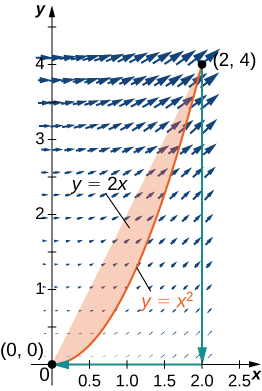
Evaluate line integral
where C is oriented in a counterclockwise path around the region bounded by
and
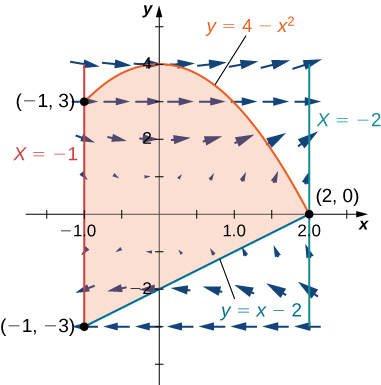
For the following exercises, use Green’s theorem to find the area.
Find the area between ellipse
and circle
Find the area of the region enclosed by parametric equation
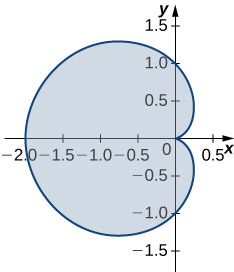
Find the area of the region bounded by hypocycloid
The curve is parameterized by
Find the area of a pentagon with vertices
and
Use Green’s theorem to evaluate
where
is the perimeter of square
oriented counterclockwise.
Use Green’s theorem to prove the area of a disk with radius a is
Use Green’s theorem to find the area of one loop of a four-leaf rose
(Hint:
Use Green’s theorem to find the area under one arch of the cycloid given by parametric plane
Use Green’s theorem to find the area of the region enclosed by curve

[T] Evaluate Green’s theorem using a computer algebra system to evaluate the integral
where C is the circle given by
and is oriented in the counterclockwise direction.
Evaluate
where C is the boundary of the unit square
traversed counterclockwise.
Evaluate
where C is any simple closed curve with an interior that does not contain point
traversed counterclockwise.
Evaluate
where C is any piecewise, smooth simple closed curve enclosing the origin, traversed counterclockwise.
For the following exercises, use Green’s theorem to calculate the work done by force F on a particle that is moving counterclockwise around closed path C.
C : boundary of a triangle with vertices (0, 0), (5, 0), and (0, 5)
Evaluate
where C is a unit circle oriented in the counterclockwise direction.
A particle starts at point
moves along the x-axis to (2, 0), and then travels along semicircle
to the starting point. Use Green’s theorem to find the work done on this particle by force field
David and Sandra are skating on a frictionless pond in the wind. David skates on the inside, going along a circle of radius 2 in a counterclockwise direction. Sandra skates once around a circle of radius 3, also in the counterclockwise direction. Suppose the force of the wind at point
is
Use Green’s theorem to determine who does more work.
Use Green’s theorem to find the work done by force field
when an object moves once counterclockwise around ellipse
Use Green’s theorem to evaluate line integral
where C is ellipse
oriented counterclockwise.
Evaluate line integral
where C is the boundary of a triangle with vertices
with the counterclockwise orientation.
Use Green’s theorem to evaluate line integral
if
where C is a triangle with vertices (1, 0), (0, 1), and
traversed counterclockwise.
Use Green’s theorem to evaluate line integral
where C is a triangle with vertices (0, 0), (1, 0), and (1, 3) oriented clockwise.
Use Green’s theorem to evaluate line integral
where C is a circle
oriented counterclockwise.
Use Green’s theorem to evaluate line integral
where C is circle
oriented in the counterclockwise direction.
Use Green’s theorem to evaluate line integral
where C is ellipse
and is oriented in the counterclockwise direction.
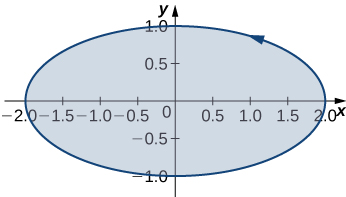
Let C be a triangular closed curve from (0, 0) to (1, 0) to (1, 1) and finally back to (0, 0). Let
Use Green’s theorem to evaluate
Use Green’s theorem to evaluate line integral
where C is circle
oriented in the clockwise direction.
Use Green’s theorem to evaluate line integral
where C is any smooth simple closed curve joining the origin to itself oriented in the counterclockwise direction.
Use Green’s theorem to evaluate line integral
where C is the positively oriented circle
Use Green’s theorem to evaluate
where C is a triangle with vertices (0, 0), (1, 0), and (1, 2) with positive orientation.
Use Green’s theorem to evaluate line integral
where C is ellipse
oriented in the counterclockwise direction.
Let
Find the counterclockwise circulation
where C is a curve consisting of the line segment joining
half circle
the line segment joining (1, 0) and (2, 0), and half circle
Use Green’s theorem to evaluate line integral
where C is a triangular closed curve that connects the points (0, 0), (2, 2), and (0, 2) counterclockwise.
Let C be the boundary of square
traversed counterclockwise. Use Green’s theorem to find
Use Green’s theorem to evaluate line integral
where
and C is a triangle bounded by
oriented counterclockwise.
Use Green’s Theorem to evaluate integral
where
and C is a unit circle oriented in the counterclockwise direction.
Use Green’s theorem in a plane to evaluate line integral
where C is a closed curve of a region bounded by
oriented in the counterclockwise direction.
Calculate the outward flux of
over a square with corners
where the unit normal is outward pointing and oriented in the counterclockwise direction.
[T] Let C be circle
oriented in the counterclockwise direction. Evaluate
using a computer algebra system.
Find the flux of field
across
oriented in the counterclockwise direction.
Let
and let C be a triangle bounded by
and
oriented in the counterclockwise direction. Find the outward flux of F through C.
[T] Let C be unit circle
traversed once counterclockwise. Evaluate
by using a computer algebra system.
[T] Find the outward flux of vector field
across the boundary of annulus
using a computer algebra system.
Consider region R bounded by parabolas
Let C be the boundary of R oriented counterclockwise. Use Green’s theorem to evaluate
is a source-free vector field, then stream function g is a function such that
and

You can also download for free at http://cnx.org/contents/9a1df55a-b167-4736-b5ad-15d996704270@5.1
Attribution: